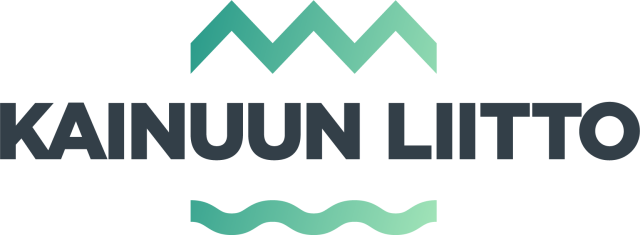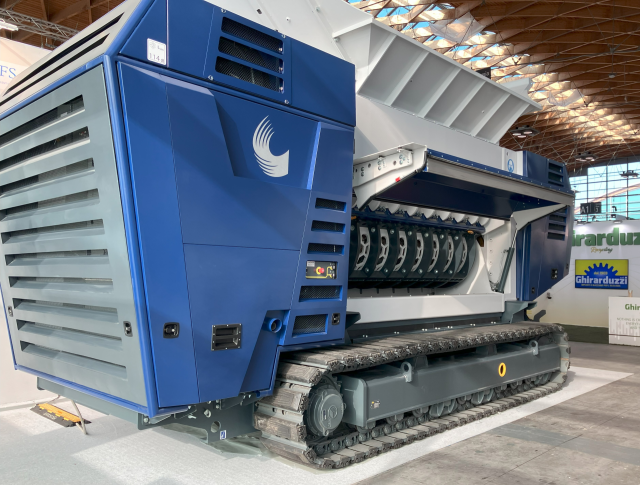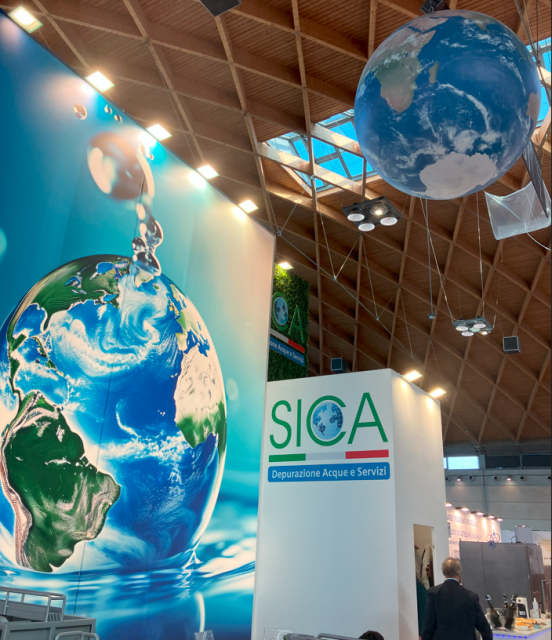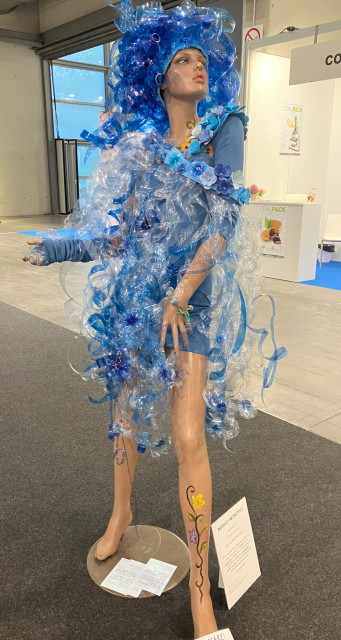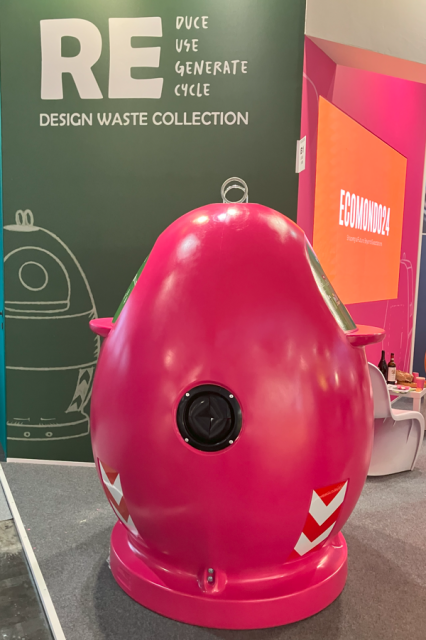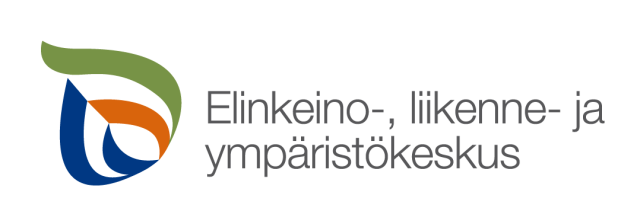The ECOMONDO Green Technology Expo for circular economy took place in Rimini, Italy, from Nov 5 to Nov 8, 2024. An extensive circular economy and research conference took place in connection with ECOMONDO, encompassing 70 sessions across 13 themes. Created in the HUDA project, the conference also showcased an instrument used for measuring microplastics in runoff water.
As part of the Waste Management Association JHY’s ten-person strong delegation, participants from CEMIS at the ECOMONDO Expo included Jarmo Hietanen (University of Oulu) and Pihla Hasan (Kajaani University of Applied Sciences). They networked and exchanged the latest information on circular economy between the business life, the research sector and the third sector.
Massive machinery and services, smart applications included
With 1,600 exhibitors hard at work, the expo showcased machines and equipment that make recycling possible. Also on display was a wide range of service offerings for environmental measurements and training, licensing and quality processes as well as product standardisation. Turnkey services and solutions ranged from biogas, hydrogen, methane and recycled plastic processing plants to water treatment plants and waste export.
On exhibit were also logistics solutions for the green transition, including large trucks with electric powertrains, bucket loaders, as well as sweepers and other machinery capable of negotiating small alleyways. From a more industrial perspective, the expo showcased mechanical devices for sorting, crushing, tearing, pressing and baling recyclable materials for further processing or generating raw materials for products. In waste sorting, the displayed items included vibration technology, fans, suction systems, electric and magnetic fields, along with related auxiliaries and robots.
Image 1. Material crusher designed for high volumes.
Waste identification technologies included precision cameras, near-infrared scanners and spectrometers, capacitive sensing, eddy current separators and magnetic waste separators along with various software and AI applications. We were happy to learn that the hyperspectral camera developed in Oulu was well-known and considered reliable.
Water management and measuring instruments
For the purpose of runoff water management and filtering, the expo presented structural elements made from recycled plastic that can be quickly assembled and filled with various soils. Catwalks and bridges were manufactured from recycled plastic with the same principle.
For the water-intensive sector, product offerings included pumps, valves, solids separators, grinders, chemical feed systems, as well as water and slurry tanks. On the sensor front, pickings were somewhat slimmer. They did showcase, however, traditional solids measurement devices, level indicators and flow meters as well as pH and conductivity sensors. Available products included traditional copper cable and IoT interfaces for water quality monitoring for the food, agriculture, well, watercourse, and industrial sectors as well as the extractive industry. Further on display were laboratory equipment used for analysing metals and gases dissolved in samples. No general-purpose equipment for measuring microbial content in metal or water were exhibited.
Image 2. The exhibition districts featured visually impressive showcases.
Implications of EU legislation; end-of-life textiles and plastic return bottles
New EU rules for materials recycling and EU’s Packaging and Packaging Waste Regulation (PPWR) made their impact felt at the expo, particularly in the separate collection and recycling of end-of-life textiles and plastic bottles. Machines and equipment for processing end-of-life textiles have recently seen significant technological advancements. However, identification databanks and models lag far behind when compared to plastics identification which has already seen 20 years of active development. The current processing speed for automated equipment for end-of-life textiles is 1 to 2 tonnes per hour.
Sorting equipment may already be selling and making good business, but the market is challenging for recycled fibres. While second-hand clothes have a stable aftermarket and end-of-life textiles and leftover fabrics recycling is seeing profitable growth in some manufacturing industries and service segments, recycling fibres in consumer textiles still needs new business ideas and innovations.
Image 3. A futuristic dress made of plastic bottles was one of the pieces displayed in the recycled textile exhibition.
For the separate collection of plastic bottles, a variety of ‘sorting cabinets’ and solutions were showcased in a wide colour palette. Also taking part were several equipment and raw materials providers specialised in processing plastic bottles. In Finland, we learn from a very young age to return any deposit beverage bottles and cans to the store. Our return rate is top class, and we hit a new record in 2023 (source: Suomen Palautuspakkaus – Palpa). It remains to be seen, however, whether the bottle return system in Finland is sufficient as it is now or if EU’s new PPWR regulation requires that we upgrade our return points.
So many portable toilets and bins for separate waste collection!
They were aplenty, and they were the very best the expo had to offer, at least for ‘someone attuned to waste and circular economy’ (Pihla). Sorting is no longer a tedious undertaking, and you do not have to hide your separate waste collection bins behind a corner anymore. There are cute animal motifs, new shapes and tailored solutions, for both above ground and under. In addition to individual collection bins, entire sorting stations were on display, the most innovative being a shipping container for collecting electronic appliances and other WEEE waste.
Image 4. New colours and shapes for a glass waste collection bin.
Recycling logistics demonstrations ranged from simple waste bins to remotely monitored waste containers that provide user guidance. The collection bins featured technology for both authentication and waste weighing. Smart and logistics applications were used for identifying the fill level of a waste bin and adding collection to optimised collection routes. Solar power was also harnessed to reduce the volume of the waste and enable technical functionalities.
Separate collection of biowaste and composting played a prominent role. In addition to electric composters primarily designed for the food industry, options for consumers were also available, even electric composters designed to be placed by the road. In addition to separately collected regular waste, new waste fractions were also introduced, with diapers among the most unusual. Collecting used cooking oil is popular in Europe, as indicated by the number of options for cooking oil collection containers.
In addition to waste bins, portable toilets made an impression with a wide variety of colour options on full display. The range of portable toilets also included shipping container solutions featuring multiple toilets. New designs were especially notable in urinals. There was even a urinal designed for women on display, along with a ‘field hospital’ built in a portable toilet with defibrillators and medical instruments.
From recycled materials to products
Recycling is increasingly moving towards a full circle where no raw material are wasted, very little waste is generated and side streams are effectively utilised. Recovery, scrubbing and utilisation of carbon dioxide produced by recycling and production plants is one of the newest innovations in circular economy. Along with electricity and biogas, vehicles are increasingly powered by alternative fuels, such as hydrogen and methane.
Waste and materials separation has also reached new heights. Waste streams are no longer separated to just plastics, metals and other materials. Advanced identification and separation technologies now help separate various plastic waste fractions and metals in waste streams. This helps significantly increase materials recycling and reuse.
A wide variety of bags, boxes, cups and containers were on display, representing packaging manufactured from recycled fibres. Application areas included cutlery, various commercial items as well as storing and sorting applications. And in fact, exhibition districts displayed many consumer durables made from cardboard, including chairs and armchairs, tables, drawers, lamps, partitions and wall surfaces, even if they were only manufactured for the expo. We were delighted, however, to see the recycled materials that companies use in the products they sell, as well as ‘eco-design.’
Recycling is a collaborative effort binding many sectors and industries together with an important role for each; we need both small and large businesses as well as equipment and innovation to effectively collect not only small volumes of high-value metals but also the tonnes and tonnes of high-volume materials.
Blog images: Pihla Hasan
Learn more about the projects:
HUDA – Data-based management for runoff water and waste flows in Kainuu
UURA – Measurement technologies for industry
BIOPAK – Recycling of wood-fibre packaging
KIMARA – Identifying textiles and plastics
ATP – Microbiological concentrations in water-intensive processes
